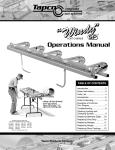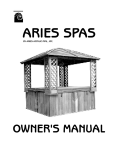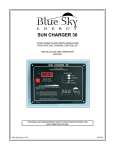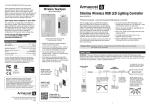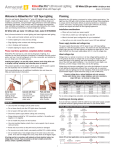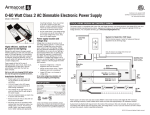Download Instructions - Gryphon Corporation
Transcript
Diam o el C od Band Saw M d n ® Ma de in U S A Instructions Gryphon Diamond Band Saw model C–40 Safety Precautions • Always wear eye protection • • Do not run blade dry • • Keep fingers clear of moving parts • • Lift off motor when cleaning Your new Gryphon Diamond Band Saw is warranted for one year from date of purchase. All mechanical parts with the exception of the blade, blade guide and sponge are guaranteed against failure for one year. If such a failure occurs for any reason other than abuse or misuse during this period, it will be repaired (or at our option replaced) free of charge FOB our factory. Retain your sales receipt for proof of purchase. Should repairs ever be required, return the saw to Gryphon Corporation. © 1997 Gryphon Corporation 12417 Foothill Blvd. • Sylmar • California • 91342 • (818) 890-7770 Pivot Screw DO NOT TWIST Pivot Screw DO NOT TWIST Motor Cover Spring Slide Slide Support Bar Upper Wheel Band Motor Cradle Collar Cover Guide aw D iam dS Ba ond n ® M ad Motor Cap Adjustment Screw e in U S A Upper Guide Holder Post Lower Wheel Guard Collar Post Lower Shaft Assembly Blade Band O-Rings Washer Lower Shaft Screw Washer O-Rings Adjustment Screw Lower Shaft Screw Chassis Platform Guide Guide Holder Read this before sawing ~ 40 mile per hour blade speed CONGRATULATIONS You have purchased the world’s fastest diamond band saw. The cutting speed approaches but just stays under the speed limit where glass underwater glows during cutting. PRECAUTIONS Keep your fingers away from the moving blade Keep your water level near the top of the sponge in the water tray (see page 6). As this sponge wears the amount of cooling water delivered to your glass is reduced and glass damage will occur. If the glass you are cutting appears dry, change the sponge. Sponges should be 1/2” thick. Do not bend or kink your blade. Heavy saw vibrations result from running bent blades. Use only Gryphon #301 blades on this high speed saw. Blades from other manufacturers cannot withstand 40 m.p.h. Other blades usually make the saw vibrate and run at a high noise level because of their poor quality. After 2 to 4 hours of running time other blades will break. Your saw warranty is separate from your blade warranty. See the blade box for blade warranty. You own a high speed tool. We urge you to read the instructions entirely. Index Assembly ................................................................................................................................... Blade Installation ................................................................................................................... Cleaning the Saw ................................................................................................................... Cutting Glass .......................................................................................................................... Cutting Other Materials ....................................................................................................... Exploded View ................................................................................................................... Lower Guide Installation ........................................................................................................ Marking your Pattern ................................................................................................................. Platform & Cover Installation ................................................................................................. Read this before sawing --- 40 mile per hour blades ............................................................ Replacement Parts ................................................................................................................... Replacing Lower Wheel Adjustment Screw ............................................................................ Replacing Lower Wheel Bushing .............................................................................................. Safety Precautions ................................................................................................................... Sponge and Water Installation .................................................................................................. Trial Run & Blade Adjustment ................................................................................................. Unpacking .................................................................................................................................. Upper Guide Installation .......................................................................................................... Warranty ....................................................................................................................................... 4 4 7 6 7 2 5 6 6 3 8 7 8 1 6 5 4 5 1 Unpacking~ Your shipping carton contains the following parts: • Top Assembly • Bottom Assembly with Guide Holder installed • Platform • Blade (coiled in box) • Upper Blade Guide Holder • 3 Guides • Two Sponges • Spare Lower Adjustment Screw and two nuts* • These Instructions DO NOT turn either Adjustment Screw. These are preset for your Blade at the factory. The use of these Adjustment Screws is explained further on in this booklet. aw D iam dS Ba ond n ® M ad e in U S A Cover Top Assembly Slide Assembly~ Assembly is very simple. Refer to the drawing on this page. • Remove tape used in packing. • Insert Slides on Top Assembly into Posts on Bottom Assembly as shown. Blade • Push Top Assembly down as far as it will go (note that the Adjustment Screw controls how far down the Top Assembly will go). Do not turn the Upper Adjustment Screw yet. Platform • Remover Cover by sliding it straight up. Bottom Assembly Blade Installation~ • Remove coiled Blade from box. • Uncoil the Blade gently. Do not bend or kink the Blade. • Place Blade under Lower Wheel with diamond side towards the front of the saw. • Place Blade at 9 O’clock position on Upper Wheel and rotate Upper Wheel by hand clockwise to wrap the blade over the Upper Wheel. Blade should pass through slot in Guide. • Turn Upper Wheel by hand until the Blade walks to the back of the Upper Wheel. Trial Run & Blade Adjustment~ • Route power cord through the slot provided in Top Assembly and plug into a standard grounded outlet. The upper Adjustment Screw was factory set. Use the following steps to make your own adjustment. • While pressing down gently on the back of the Motor (to keep tension on the Blade), flip the on/off switch to the “on” position. • By tightening the Adjustment Screw you raise the Motor back and bring the Blade toward the front of the Upper Wheel. Loosening this screw will bring the Blade towards the back of the Upper Wheel. • Tighten the Adjustment Screw until the blade has minimum wobble but stays in the Guides. If the saw becomes louder and vibrates, loosen the Adjustment Screw until the saw quiets down. • You will not need to adjust the Lower Adjustment Screw. This control for the tilt of the Lower Wheel was set at the factory and should not require further attention. • Turn the saw off. On Off Adjustment Screw Lower Guide Installation~ • Your saw was shipped with the Guide Holder in place. If it has become loose or fallen out in shipment, reinsert it into slot on inside wall of Chassis. Push firmly into place so that top of Guide Holder is flush with top of Chassis. • Slide one Guide into slot on Guide Holder (slot on Guide must face out). • Blade fits in slot of Guide. Upper Guide Installation~ • Install a Guide into the Upper Blade Guide Holder in the same way as you installed the Guide into the Lower Guide Holder. • Install the Upper Blade Guide Holder onto your band saw by inserting it over the rear right-hand corner of the Motor Cradle as shown. • The Upper Blade Guide Holder may be removed or reinstalled at any time. Blade Guide Upper Blade Guide Holder Sponge and Water Installation~ • The sponges reduce the water splash. • Wet both Sponges. • Insert sponges in locations shown in cutaway drawing at right. Ridges are molded into the saw to keep the sponges in place. • Pour water into chassis. Water level should not be higher than the top of the bottom sponge. The use of a corrosion inhibitor or other additive in the water is not recommended as it will not benefit the function of the saw. • Rotate or replace sponges when worn. • Additional sponges can be cut from a standard kitchen sponge available at your grocery store. Top Sponge Platform & Cover Installation~ Bottom Sponge Ba ond n aw D iam dS • The Platform is installed with the texture side up. • When installed, the Platform surface will be flush with the top of the Chassis. • Install the Platform by sliding it into place as shown. Be very careful not to nick or bend the Blade while installing the Platform. • The Cover, which you removed to install the Blade, is reinstalled simply by sliding it down the front of the Top Assembly until it sits flush. ® M ad e in U S A Cover Marking your Pattern~ Since the Blade carries cooling water to the glass surface, your pattern will need to be resistant to water. The best technique is to mark your pattern on the glass with a thin-line paint marker (such as the Gryphon Pattern Marking Pen). These are available from your dealer, or similar products can be obtained from artist’s supply houses. Cutting Glass~ When cutting, push your work with only a moderate pressure. Very heavy pressure will not result in faster cutting, and may bend the blade. When cutting Platform curves, use only a light pressure and let the blade do the work. Aggressive pressure against the blade when cutting curves causes rapid wear to the back of the blade. Do not force the blade to follow a pattern, but rather guide the work through the blade. This will insure you of the longest possible blade life. When backing out of a slot, turn motor off. Hold your thumb against the front of the blade while carefully backing the glass. Remove your thumb and start the motor. It is normal for a blade to cut more slowly as it wears. Some materials, such as lead crystal, load the blade and cutting action slows significantly after a time. Good cutting action will be immediately restored with only a little cutting into a piece of clear window glass, silicon carbide, or a brick. Cutting Other Materials~ The diamond blade on your band saw is useful for cutting a variety of hard materials. Stone, tile, ceramics and similar materials can be cut as easily as glass. The speed at which the saw cuts will be determined by the thickness and the hardness of the material being cut. Harder materials will wear the blade faster. Metals are too soft to be cut by a diamond blade and will gum up the blade. Cleaning the Saw~ The glass dust that results from your cutting is carried to the bottom of the saw where it combines with the water to form a slurry. When the water becomes objectionably dirty you should clean out this slurry as follows: • Remove Platform & Cover. • Remove Blade. • Remove Top Assembly by pulling straight up. • Pour out dirty water outside. Do not pour into plumbing as the slurry can cause clogs. • Use a paper towel to remove heavy slurry if required. • Rinse out Bottom Assembly with a garden hose if desired. • Do not use solvents to clean any part of the saw. Soapy water is all that is required. • If you remove the Guide Holder, clean it thoroughly before replacing to insure that it fits flush. Replacing Lower Wheel Adjustment Screw~ If it should ever become necessary to replace the Lower Adjustment Screw (used for adjusting the tilt on the Lower Wheel), proceed as follows: (1) Remove old Lower Adjustment Screw and both nuts (the rear nut is glued to the knob, and the easiest way to remove it is by cutting it off with a sharp knife). (2) Pass new Lower Adjustment Screw through hole in plastic arm. (3) Twist two nuts half way onto Lower Adjustment Screw. (4) Screw Lower Adjustment Screw into hole in Lower Shaft Assembly. (5) Twist nut nearest the Plastic Arm so that it almost touches Plastic Arm, but still allows knob to turn. Locking Nuts Lower Adjustment Screw Plastic Arm Lower Wheel Lower Shaft Assembly (6) Install the blade and rotate the Upper Wheel by hand while turning Lower Adjustment Screw in or out until the blade runs near the shoulder at the back of the Lower Wheel. (7) Turn saw on and twist Lower Adjustment Screw until blade runs quiet and almost touches shoulder of Lower Wheel. (8) Tighten both Locking Nuts. Replacing Lower Wheel Bushing~ If it should ever become necessary to replace the Lower Wheel Bushing, proceed as follows: (1) Remove the Lower Wheel by first removing the stainless steel collar at the front of the wheel shaft, then pull the Lower Wheel and all the washers and O-rings off of the shaft. (2) Wipe the shaft clean and, if necessary, clean up the shaft with steel wool. Lubricate the shaft thinly with Vasoline. (3) Pull the old bushings out of the Lower Wheel with pliers*. Screw Driver Lower Wheel Bushing Teflon Washer O-ring Wood Block (4) Push the new bushings into the Lower Wheel so that the bushing ears slip into the notches in the wheel hub. Put the assembly on the floor and step on it to firmly press the bushings into position. (5) Push new O-rings into the recesses in each bushing. (6) Place on shaft: (a) Lower Wheel (be sure that the front O-ring stays in the recess) (b) collar Push the above group of parts tightly against the Lower Shaft Assembly. Tighten the set screw. Replacement Parts~ Genuine Gryphon Diamond Blades and Blade Guides are available through your dealer. Replacement Sponges are available in most grocery stores. For other parts or warranty service, contact the factory in Sylmar, California. Gryphon Corporation. © 1997 Gryphon Corporation 12417 Foothill Blvd. • Sylmar • California • 91342 • (818) 890-7770








